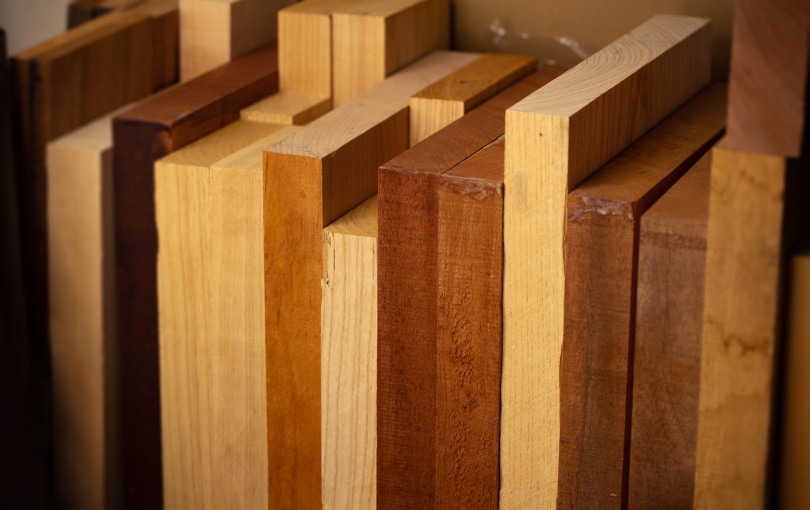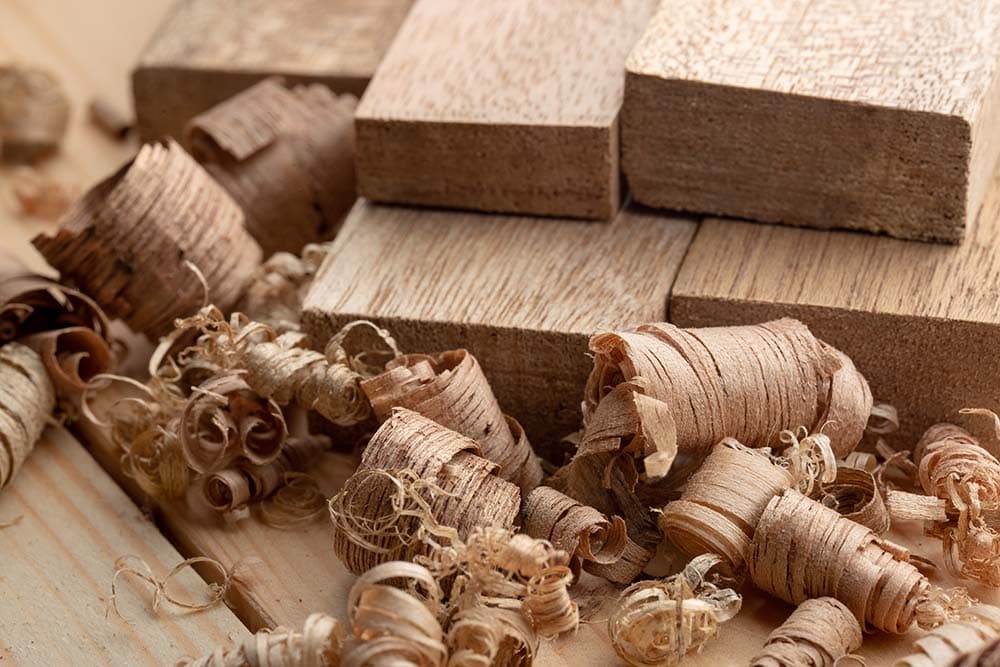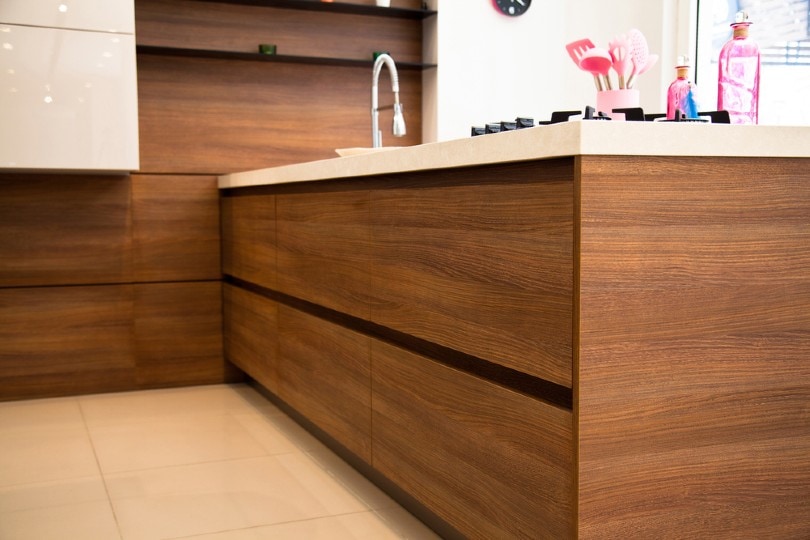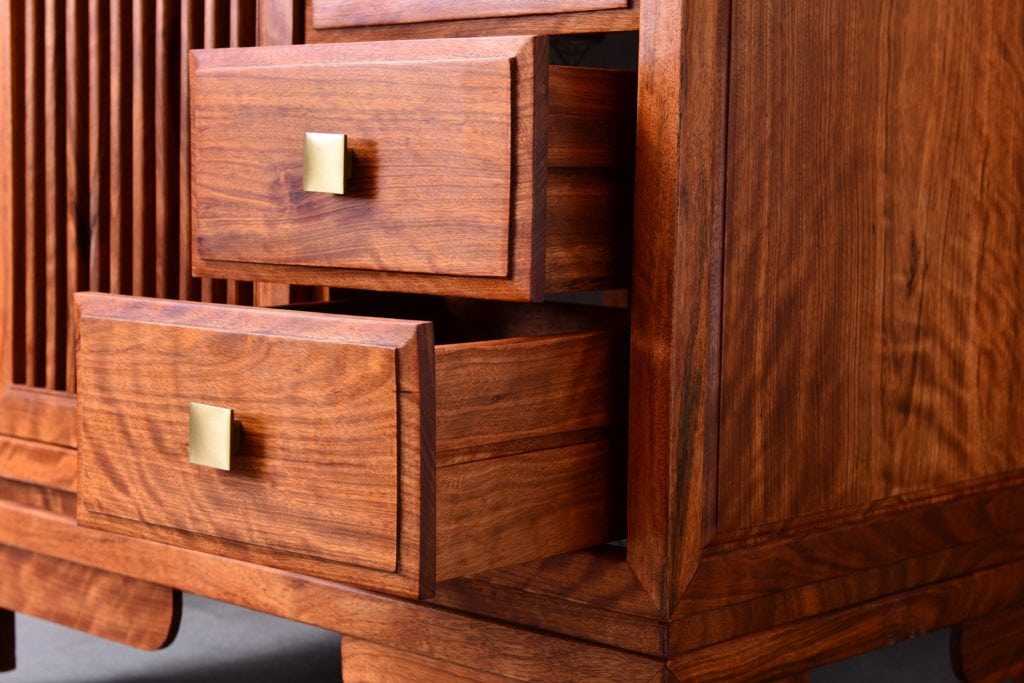Mahogany vs Walnut: Pros, Cons, Characteristics, & Differences
-
Pete Ortiz
- Last updated:

What is the best wood for your project? Both mahogany and walnut are hardwoods. They’re becoming more popular in today’s home projects. They’re both ideal for construction projects due to the natural beauty of their grains and features.
But, before you choose which one to use in your project, it’s crucial to learn about the differences between them. Each has its distinct characteristics and benefits.
So, how do you decide which one to use for your next project? Here, we’ll explore the pros and cons of each wood and why they’re better than the other. We’ll also discuss several differences between mahogany and walnut and what’s ideal for your next project. So, let’s jump right in!
Overview of Mahogany

Mahogany is a hardwood often used in furniture and musical instruments. The mahogany tree is native to South America and Mexico. You can find it growing in moist conditions.
The wood is dense and hard. Mahogany’s grain is straight with an even texture. The wood has a medium density and excellent dimensional stability. It makes it ideal for use in high-quality workmanship.
The mahogany tree takes about 25 years to grow to maturity. It can grow up to 75 feet tall, with a trunk diameter of approximately one meter.
What Is Mahogany Good For?
Mahogany is excellent in many applications.
- Construction: It has many uses in the construction industry, including the construction of railroad ties, bridges, and agricultural equipment.
- Furniture: This is the most common use of mahogany wood. You can make furniture such as doors, chairs, beds, and cabinets.
- Floors: Mahogany floors are beautiful and elegant because they have a unique grain pattern. They are also durable because they can withstand heavy foot traffic.
- Boat Building: Mahogany is ideal for boat building. It has excellent strength properties when dried well after harvesting.
Characteristics of Mahogany
1. Color
Mahogany is a medium to dark brown wood. It has a reddish-brown to brown color when cut. It also has a coarse texture. The wood is dense and heavy, making it resistant to warping, swelling, and shrinking. Its dense nature gives it the ideal weight for furniture making.
2. Hardness
The hardness level of mahogany is determined by two primary factors: moisture content and density. The higher the moisture content in the wood, the higher its hardness value will be.
Mahogany has a Janka score of 800–900. The Janka score is the measure of the hardness of wood.
Mahogany is hard compared to other types of wood, such as oak or pine. It’s excellent for outdoor projects such as decking or outdoor furniture.
3. Durability
Mahogany is one of the most durable woods. It makes it a popular choice for furniture and other projects. It can last almost forever with only minimal maintenance.

4. Maintenance
Maintenance of mahogany is not challenging. Ensure you keep it away from direct sunlight or high temperatures. Also, keep it away from water as it’ll cause your mahogany furniture to warp and crack.
5. Grain
The grain of mahogany is straight and consistent throughout the tree. It can be challenging to distinguish between the different varieties of mahogany.
Usually, the grain in mahogany produces streaks darker than the rest of the wood. It can make it seem almost black. Also, this can give the appearance of grain lines on some pieces of furniture.
- Strong and durable
- Water-resistant
- Has an attractive appearance and wood grain
- Rot-resistant
- Easy to work with
- Maintains paint and polishes well
- Has a uniform color
- You can screw or nail it
- It doesn’t warp or shrink during winter or summer
- It gets darker with time due to exposure to sunlight
- Identifying mahogany species can be challenging
- It’s quite heavy
- Finding mahogany wood with the same color is challenging
- It’s has become costly
- Limited production due to a shortage of wood
Overview of Walnut

Walnut wood is one of the most popular woods for furniture, flooring, and cabinets. It’s ideal for projects that need a durable finish. It comes in many colors and finishes.
Walnut wood comes from the walnut tree. Walnut trees grow between 30–37 meters tall. Their trunks grow up to 90 centimeters in diameter at maturity. They live for about 150 years.
The leaves on walnut trees are small, thin, and pointed at both ends. They are arranged in whorls around the branches of the tree. They grow up to 6 inches long. Also, they have serrated edges.
What Is Walnut Wood Good For?
- Furniture: Walnut wood is used to make furniture such as chairs, tables, and cabinets. Its grain pattern makes it look rich and elegant.
- Fine Arts: Walnut wood is used to make paintings and sculptures because of its beauty and durability.
- Interior Design: You can use walnut wood as a decorative element in your office or home space in the kitchen and around your fireplace or mantel.
- Carving Wood: You can also use walnut wood for carving. It has a smooth surface that makes it ideal for carving wooden sculptures or other forms of artwork.
Characteristics of Walnut Wood
1. Color
The color of walnut wood can vary from light to deep brown heartwood. Some have a reddish hue, but the most common color is brown. The color depends on the type of wood and its origin.
2. Hardness
Walnut is a hardwood that is known for its strength and durability. The wood’s density makes it resistant to warping. It makes it an excellent choice for planks and boards.
Although it is not the hardest wood, it’s still durable enough to make high-end furniture. Also, it’s harder than mahogany. The Janka score of walnut wood is 1,010. It’s a moderately hard wood.
3. Durability
Walnut is one of the most durable woods available. It’s strong, holds up well, and is easy to work with. It can withstand heat, cold, and moisture. A walnut floor is easy to maintain.
However, when carving walnut wood, you must be careful not to expose its darker color. It will darken when exposed to light and may crack or split. Otherwise, with its exceptional strength, it’s an excellent choice for furniture and other applications where strength is crucial.

4. Maintenance
Walnut is a hardwood. It means it can withstand more than other woods. But this doesn’t mean that you shouldn’t care for your walnut furniture. It needs proper maintenance to remain beautiful and usable for many years.
5. Grain
The grain in walnut wood is irregular but straight with a medium texture and a high degree of uniformity among pieces. It has a fine tight grain pattern when finished.
Walnut wood is also known for its beautiful colors and patterns. They include gray, brown, or black streaks running through the grain.
- Highly resistant to wear and tear
- Can be an alternative to tropical wood
- It’s available in many color options
- It has an attractive wood grain
- Excellent balance of eco-friendly nature
- It’s durable
- Working with walnut wood is easy if you have the experience
- Stains and polishes well
- It can bleach due to exposure to the sun
- It’s not resistant to moisture and weather
- Rare wood, and, therefore, it’s costly
- May get scratched by sharp objects
- You must apply sealant on the walnut wood surface after several years
- It’s heavy
What Are the Differences Between Mahogany and Walnut?
While mahogany and walnut are both beautiful and strong woods, they have different characteristics. Here’s a look at the primary differences between them.
Appearance
The primary difference between mahogany and walnut wood is the color. Mahogany is a reddish-brown wood with a grain pattern that resembles a tree’s bark. Besides, mahogany has an antique and classic appearance.
Walnut wood is understated and more contemporary. It has a more consistent color, ranging from dark brown to black. Both species are available in different widths and grades. You can select the one that looks best on your project.
Strength
Walnut is stronger than mahogany due to its higher density and roundness. The density of walnut can be as much as twice that of mahogany. Its roundness makes it less prone to cracking or splitting during drying or transportation. It makes walnut wood ideal for high-pressure steam boxes used in manufacturing plants. It’s also ideal in other industrial settings where heavy loads are transported over long distances.

Hardness
Walnut is known for its high density and strength. Its hardness makes it resistant to dents and dings, even after years of use. Besides, walnuts have a higher density than other woods such as mahogany.
Mahogany is softer than walnut wood. So, it’s more susceptible to damage when used as a building material.
Weight
Another primary difference between these two kinds of wood is their weight. Walnut weighs more than mahogany, with a density of approximately 36–38 pounds per cubic foot compared to 31–33 pounds per cubic foot for mahogany wood.
It is easier to work with walnut than other timbers because it does not need as much bracing or support to be structurally sound.
Grain
Usually, the grain pattern of mahogany wood is straight, but in some cases, there are wavy lines. Walnut is also a hardwood tree with dark brown or blackish color. Its grain pattern is more complex than that of mahogany. It’s also straight but has a medium texture.
Cost
Walnut is harder than mahogany. So, it costs more to produce and is more expensive to ship than mahogany.
Walnut is often used in furniture but not popular for home use. This is due to its high cost and difficulty in finding suitable colors.

Which One Is Right for You?
A suitable wood for you depends on your aesthetics. Both mahogany and walnut are excellent woods.
Mahogany has been used for many years to make furniture, flooring, and other items, but it is expensive to buy. It’s also challenging to work with.
Walnut is also hard but has a smoother surface than mahogany. It makes it easier to work with. It also allows for more detailed designs or carvings on pieces of furniture or other items.
If you want wood you can use to make carvings, go for walnut wood. But go for mahogany if you’re on a budget. It’s all about the factors crucial to you and your personal preference.
- Constructing wood windows and doors
- Making plywood
- Boatbuilding
- Veneering
- High-end trim work
- Making guitar bodies
- Wood flooring
- Veneering
- Making musical instruments
- Making furniture
- Making carvings
- High-end trim work
- Flooring
Conclusion
So, now that you’ve considered your project and know its size, it’s time to choose between mahogany and walnut. Both are fine choices for various furniture pieces, but some differences may make one or the other more suitable for different projects.
You should know what makes each of these woods unique before committing to one or the other for your project. They each have their advantages and disadvantages, depending on your needs.
The choice between mahogany and walnut will come down to your preference. So, with this guide, you can make an informed decision.
You might also like:
- How Do Cordless Blinds Work? The Interesting Answer!
- 3 DIY Blinds You Can Make Today (With Instructions)
Featured Image Credit: (L) Jason Gilkes, Shutterstock | (R) Roca Mharas, Shutterstock
Contents



